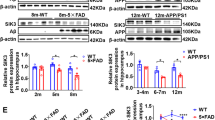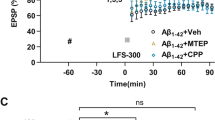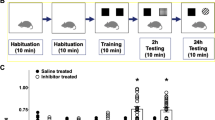Abstract
Induction of neuroprotective heat-shock proteins via pharmacological Hsp90 inhibitors is currently being investigated as a potential treatment for neurodegenerative diseases. Two major hurdles for therapeutic use of Hsp90 inhibitors are systemic toxicity and limited central nervous system permeability. We demonstrate here that chronic treatment with a proprietary Hsp90 inhibitor compound (OS47720) not only elicits a heat-shock-like response but also offers synaptic protection in symptomatic Tg2576 mice, a model of Alzheimer’s disease, without noticeable systemic toxicity. Despite a short half-life of OS47720 in mouse brain, a single intraperitoneal injection induces rapid and long-lasting (>3 days) nuclear activation of the heat-shock factor, HSF1. Mechanistic study indicates that the remedial effects of OS47720 depend upon HSF1 activation and the subsequent HSF1-mediated transcriptional events on synaptic genes. Taken together, this work reveals a novel role of HSF1 in synaptic function and memory, which likely occurs through modulation of the synaptic transcriptome.
This is a preview of subscription content, access via your institution
Access options
Subscribe to this journal
Receive 12 print issues and online access
$259.00 per year
only $21.58 per issue
Buy this article
- Purchase on Springer Link
- Instant access to full article PDF
Prices may be subject to local taxes which are calculated during checkout





Similar content being viewed by others
References
Becker RE, Greig NH, Giacobini E . Why do so many drugs for Alzheimer’s disease fail in development? Time for new methods and new practices? J Alzheimers Dis 2008; 15: 303–325.
Honig LS . Translational research in neurology: dementia. Arch Neurol 2012; 69: 969–977.
Luo W, Sun W, Taldone T, Rodina A, Chiosis G . Heat shock protein 90 in neurodegenerative diseases. Mol Neurodegener 2010; 5: 24.
Neef DW, Jaeger AM, Thiele DJ . Heat shock transcription factor 1 as a therapeutic target in neurodegenerative diseases. Nat Rev Drug Discov 2011; 10: 930–944.
Putcha P, Danzer KM, Kranich LR, Scott A, Silinski M, Mabbett S et al. Brain-permeable small-molecule inhibitors of Hsp90 prevent α-synuclein oligomer formation and rescue α-synuclein-induced toxicity. J Pharmacol Exp Ther 2010; 332: 849–857.
Dickey CA, Kamal A, Lundgren K, Klosak N, Bailey RM, Dunmore J et al. The high-affinity HSP90-CHIP complex recognizes and selectively degrades phosphorylated tau client proteins. J Clin Invest 2007; 117: 648–658.
Labbadia J, Cunliffe H, Weiss A, Katsyuba E, Sathasivam K, Seredenina T et al. Altered chromatin architecture underlies progressive impairment of the heat shock response in mouse models of Huntington disease. J Clin Invest 2011; 121: 3306–3319.
Cha JR, St Louis KJ, Tradewell ML, Gentil BJ, Minotti S, Jaffer ZM et al. A novel small molecule HSP90 inhibitor, OS47720 30001, differentially induces heat shock proteins in nervous tissue in culture and in vivo. Cell Stress Chaperon 2014; 19: 421–435.
Stetler RA, Gan Y, Zhang W, Liou AK, Gao Y, Cao G et al. Heat shock proteins: cellular and molecular mechanisms in the central nervous system. Prog Neurobiol 2010; 92: 184–211.
Moon IS, Park IS, Schenker LT, Kennedy MB, Moon JI, Jin I . Presence of both constitutive and inducible forms of heat shock protein 70 in the cerebral cortex and hippocampal synapses. Cereb Cortex 2001; 11: 238–248.
Morimoto RI . Regulation of the heat shock transcriptional response: cross talk between a family of heat shock factors, molecular chaperones, and negative regulators. Genes Dev 1998; 12: 3788–3796.
Zou J, Guo Y, Guettouche T, Smith DF, Voellmy R . Repression of heat shock transcription factor HSF1 activation by HSP90 (HSP90 complex) that forms a stress-sensitive complex with HSF1. Cell 1998; 94: 471–480.
Taipale M, Jarosz DF, Lindquist S . HSP90 at the hub of protein homeostasis: emerging mechanistic insights. Nat Rev Mol Cell Biol 2010; 117: 515–528.
Chen Y, Wang B, Liu D, Li JJ, Xue Y, Sakata K et al. Hsp90 chaperone inhibitor 17-AAG attenuates Aβ-induced synaptic toxicity and memory impairment. J Neurosci 2014; 34: 2464–2470.
Wang C, Barluenga S, Koripelly GK, Fontaine JG, Chen R, Yu JC et al. Synthesis of pochoxime prodrugs as potent HSP90 inhibitors. Bioorg Med Chem Lett 2009; 19: 3836–3840.
Yang G, Pan F, Parkhurst CN, Grutzendler J, Gan W-B . Thinned-skull cranial window technique for long-term imaging of the cortex in live mice. Nat Protoc 2010; 5: 201–208.
Wang R, Li JJ, Diao S, Kwak YD, Liu L, Zhi L et al. Metabolic stress modulates Alzheimer’s β-secretase gene transcription via SIRT1-PPARγ-PGC-1 in neurons. Cell Metab 2013; 17: 685–694.
Barluenga S, Fontaine JG, Wang C, Aouadi K, Chen R, Beebe K et al. Inhibition of HSP90 with pochoximes: SAR and structure-based insights. Chembiochem 2009; 10: 2753–2759.
Zhu H, Woolfenden S, Bronson RT, Jaffer ZM, Barluenga S, Winssinger N et al. The novel Hsp90 inhibitor NXD30001 induces tumor regression in a genetically engineered mouse model of glioblastoma multiforme. Mol Cancer Ther 2010; 9: 2618–2626.
de la Rosa X, Santalucía T, Fortin PY, Purroy J, Calvo M, Salas-Perdomo A et al. In vivo imaging of induction of heat-shock protein-70 gene expression with fluorescence reflectance imaging and intravital confocal microscopy following brain ischaemia in reporter mice. Eur J Nucl Med Mol Imaging 2013; 40: 426–438.
Kasai H, Fukuda M, Watanabe S, Hayashi-Takagi A, Noguchi J . Structural dynamics of dendritic spines in memory and cognition. Trends Neurosci 2010; 33: 121–129.
Yang G, Pan F, Gan W-B . Stably maintained dendritic spines are associated with lifelong memories. Nature 2009; 462: 920–924.
Buzsáki G, Buhl DL, Harris KD, Csicsvari J, Czéh B, Morozov A . Hippocampal network patterns of activity in the mouse. Neuroscience 2003; 116: 201–211.
Yu JY, Frank LM . Hippocampal-cortical interaction in decision making. Neurobiol Learn Mem 2015; 117: 34–41.
Brincat SL, Miller EK . Frequency-specific hippocampal-prefrontal interactions during associative learning. Nat Neurosci 2015; 18: 576–581.
Spellman T, Rigotti M, Ahmari SE, Fusi S, Gogos JA, Gordon JA . Hippocampal-prefrontal input supports spatial encoding in working memory. Nature 2015; 522: 309–314.
Westerman MA, Cooper-Blacketer D, Mariash A, Kotilinek L, Kawarabayashi T, Younkin LH et al. The relationship between Abeta and memory in the Tg2576 mouse model of Alzheimer’s disease. J Neurosci 2002; 22: 1858–1867.
Wang X, Cattaneo F, Ryno L, Hulleman J, Reixach N, Buxbaum JN . The systemic amyloid precursor transthyretin (TTR) behaves as a neuronal stress protein regulated by HSF1 in SH-SY5Y human neuroblastoma cells and APP23 Alzheimer’s disease model mice. J Neurosci 2014; 34: 7253–7265.
Yoon YJ, Kim JA, Shin KD, Shin DS, Han YM, Lee YJ et al. KRIBB11 inhibits HSP70 synthesis through inhibition of heat shock factor 1 function by impairing the recruitment of positive transcription elongation factor b to the hsp70 promoter. J Biol Chem 2011; 286: 1737–1747.
Jung AE, Fitzsimons HL, Bland RJ, During MJ, Young D . HSP70 and constitutively active HSF1 mediate protection against CDCrel-1-mediated toxicity. Mol Ther 2008; 16: 1048–1055.
Neckers L . Hsp90 inhibitors as novel cancer chemotherapeutic agents. Trends Mol Med 2002; 8: S55–S61.
Whitesell L, Lindquist SL . HSP90 and the chaperoning of cancer. Nat Rev Cancer 2005; 5: 761–772.
Luo W, Dou F, Rodina A, Chip S, Kim J, Zhao Q et al. Roles of heat-shock protein 90 in maintaining and facilitating the neurodegenerative phenotype in tauopathies. Proc Natl Acad Sci USA 2007; 104: 9511–9516.
Marcuccilli CJ, Mathur SK, Morimoto RI, Miller RJ . Regulatory differences in the stress response of hippocampal neurons and glial cells after heat shock. J Neurosci 1996; 16: 478–485.
Batulan Z, Shinder GA, Minotti S, He BP, Doroudchi MM, Nalbantoglu J et al. High threshold for induction of the stress response in motor neurons is associated with failure to activate HSF1. J Neurosci 2003; 23: 5789–5798.
Carnemolla A, Lazell H, Moussaoui S, Bates GP . In vivo profiling reveals a competent heat shock response in adult neurons: implications for neurodegenerative disorders. PLoS One 2015; 10: e0131985.
Riva L, Koeva M, Yildirim F, Pirhaji L, Dinesh D, Mazor T et al. Poly-glutamine expanded huntingtin dramatically alters the genome wide binding of HSF1. J Huntingtons Dis 2012; 1: 33–45.
Conrad CD . Chronic stress-induced hippocampal vulnerability: the glucocorticoid vulnerability hypothesis. Rev Neurosci 2008; 19: 395–411.
Gerges NZ, Tran IC, Backos DS, Harrell JM, Chinkers M, Pratt WB et al. Independent functions of hsp90 in neurotransmitter release and in the continuous synaptic cycling of AMPA receptors. J Neurosci 2004; 24: 4758–4766.
Bastos AM, Vezoli J, Bosman CA, Schoffelen JM, Oostenveld R, Dowdall JR et al. Visual areas exert feedforward and feedback influences through distinct frequency channels. Neuron 2015; 85: 390–401.
Buzsaki G, Schomburg EW . What does gamma coherence tell us about inter-regional neural communication? Nat Neurosci 2015; 18: 484–489.
Fries P . Rhythms for cognition: communication through coherence. Neuron 2015; 88: 220–235.
Chen CC, Hsu CY, Chiu HW, Hu CJ, Lee TC . Frequency power and coherence of electroencephalography are correlated with the severity of Alzheimer’s disease: a multicenter analysis in Taiwan. J Formos Med Assoc 2013; 114: 729–735.
Hsiao FJ, Wang YJ, Yan SH, Chen WT, Lin YY . Altered oscillation and synchronization of default-mode network activity in mild Alzheimer’s disease compared to mild cognitive impairment: an electrophysiological study. PLoS One 2013; 8: e68792.
Liu Q, Li A, Gong L, Zhang L, Wu N, Xu F . Decreased coherence between the two olfactory bulbs in Alzheimer’s disease model mice. Neurosci Lett 2013; 545: 81–85.
Sankari Z, Adeli H, Adeli A . Wavelet coherence model for diagnosis of Alzheimer disease. Clin EEG Neurosci 2012; 43: 268–278.
Basar E, Basar-Eroglu C, Guntekin B, Yener GG . Brain’s alpha, beta, gamma, delta, and theta oscillations in neuropsychiatric diseases: proposal for biomarker strategies. Suppl Clin Neurophysiol 2013; 62: 19–54.
Benchenane K, Tiesinga PH, Battaglia FP . Oscillations in the prefrontal cortex: a gateway to memory and attention. Curr Opin Neurobiol 2011; 21: 475–485.
Lu Y, Ansar S, Michaelis ML, Blagg BS . Neuroprotective activity and evaluation of Hsp90 inhibitors in an immortalized neuronal cell line. Bioorg Med Chem 2009; 17: 1709–1715.
Ansar S, Burlison JA, Hadden MK, Yu XM, Desino KE, Bean J . A non-toxic Hsp90 inhibitor protects neurons from Abeta-induced toxicity. Bioorg Med Chem Lett 2007; 17: 1984–1990.
Magrané J, Smith RC, Walsh K, Querfurth HW . Heat shock protein 70 participates in the neuroprotective response to intracellularly expressed beta-amyloid in neurons. J Neurosci 2004; 24: 1700–1706.
Hoshino T, Suzuki K, Matsushima T, Yamakawa N, Suzuki T, Mizushima T . Suppression of Alzheimer’s disease-related phenotypes by expression of heat shock protein 70 in mice. J Neurosci 2011; 31: 5225–5234.
Bobkova NV, Garbuz DG, Nesterova I, Medvinskaya N, Samokhin A, Alexandrova I et al. Therapeutic effect of exogenous hsp70 in mouse models of Alzheimer’s disease. J Alzheimers Dis 2014; 38: 425–435.
Labbadia J, Novoselov SS, Bett JS, Weiss A, Paganetti P, Bates GP et al. Suppression of protein aggregation by chaperone modification of high molecular weight complexes. Brain 2012; 135: 1180–1196.
Kim E, Wang B, Sastry N, Masliah E, Nelson PT, Cai H et al. NEDD4-mediated HSF1 degradation underlies α-synucleinopathy. Hum Mol Genet 2016; 25: 211–222.
Jiang YQ, Wang XL, Cao XH, Ye ZY, Li L, Cai WQ . Increased heat shock transcription factor 1 in the cerebellum reverses the deficiency of Purkinje cells in Alzheimer’s disease. Brain Res 2013; 1519: 105–111.
Palop JJ, Mucke L . Amyloid-β–induced neuronal dysfunction in Alzheimer’s disease: from synapses toward neural networks. Nat. Neurosci. 2010; 13: 812–818.
Koffie RM, Hyman BT, Spires-Jones TL . Alzheimer’s disease: synapses gone cold. Mol Neurodegener 2011; 6: 63.
Acknowledgements
We thank Drs William E Armstrong (Anatomy & Neuroscience UTHSC) and Melloni Cook (University of Memphis) for valuable inputs, Dr Deborah Young (The University of Auckland, Auckland, New Zealand) for providing constitutively expressed AAVH-HB hsf1 viruses,28 and Tonia Rex (Vanderbilt University) for AAV-shRNA viral vector. This work is supported by NIH grants to F-FL (AG049772-01); DHH (NS091752); MPM (AG040230 & AG041935); GY (GM107469 and AG048410); WL (CA148706); KS (MH105567 and MH102445); and RO (GM107094). DHH also received support from the UTHSC College of Medicine iRISE Pilot Program. Some of the behavioral procedures were conducted at the Neuroscience Institute’s Behavioral Core at UTHSC.
Author contributions
F-FL designed research; BW, YL, LH, JC, JJL, RW, EK, YC and CJ performed research; KS, HC, AP, RSO, WL, GY, MPM, DHH and F-FL analyzed data; RC provided compound and consultation; BW and F-FL wrote the paper.
Author information
Authors and Affiliations
Corresponding author
Ethics declarations
Competing interests
The authors declare no conflict of interest.
Additional information
Supplementary Information accompanies the paper on the Molecular Psychiatry website
Supplementary information
Rights and permissions
About this article
Cite this article
Wang, B., Liu, Y., Huang, L. et al. A CNS-permeable Hsp90 inhibitor rescues synaptic dysfunction and memory loss in APP-overexpressing Alzheimer’s mouse model via an HSF1-mediated mechanism. Mol Psychiatry 22, 990–1001 (2017). https://doi.org/10.1038/mp.2016.104
Received:
Revised:
Accepted:
Published:
Issue Date:
DOI: https://doi.org/10.1038/mp.2016.104
This article is cited by
-
Proteinopathies: Deciphering Physiology and Mechanisms to Develop Effective Therapies for Neurodegenerative Diseases
Molecular Neurobiology (2022)
-
Increased levels of Stress-inducible phosphoprotein-1 accelerates amyloid-β deposition in a mouse model of Alzheimer’s disease
Acta Neuropathologica Communications (2020)
-
The epichaperome is a mediator of toxic hippocampal stress and leads to protein connectivity-based dysfunction
Nature Communications (2020)
-
In vivo evidence for the contribution of peripheral circulating inflammatory exosomes to neuroinflammation
Journal of Neuroinflammation (2018)
-
Prions, prionoids and protein misfolding disorders
Nature Reviews Genetics (2018)



